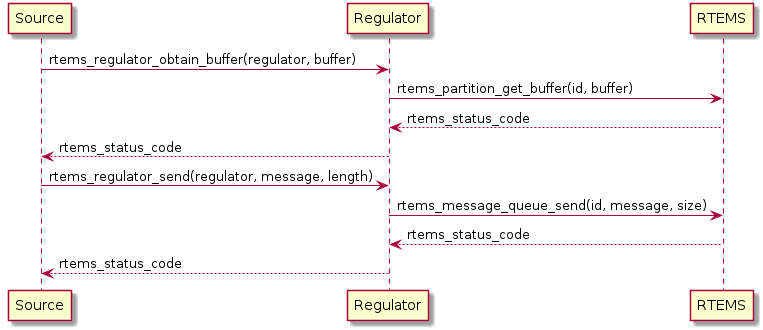29.3. Operations#
29.3.1. Application Sourcing Data#
The application interacting with the Source will obtain buffers from the regulator instance, fill them with information, and send them to the regulator instance. This allows the regulator to buffer bursty input.
A regulator instance is used as follows from the Source side:
while (1) {
use rtems_regulator_obtain_buffer to obtain a buffer
// Perform some input operation to fetch data into the buffer
rtems_regulator_send(buffer, size of message)
}
The delivery of message buffers to the Destination and subsequent release is performed in the context of the delivery thread by either the delivery function or delivery thread. Details are below.
The sequence diagram below shows the interaction between a message Source, a Regulator instance, and RTEMS, given the usage described in the above paragraphs.

As illustrated in the preceding sequence diagram, the Source usually corresponds to application software reading a system input. The Source obtains a buffer from the Regulator instance and fills it with incoming data. The application explicitly obtaining a buffer and filling it in allows for zero copy operations on the Source side.
After the Source has sent the message to the Regulator instance, the Source is free to process another input and the Regulator instance will ensure that the buffer is delivered to the Delivery function and Destination.
29.3.2. Delivery Function#
The Delivery function is provided by the application for a specific Regulator instance. Depending on the Destination, it may use a function which copies the buffer contents (e.g., write()) or which operates directly on the buffer contents (e.g. DMA from buffer). In the case of a Destination which copies the buffer contents, the buffer can be released via rtems_regulator_release_buffer() as soon as the function or copying completes. In the case where the delivery uses the buffer and returns, the call to rtems_regulator_release_buffer() will occur when the use of the buffer is complete (e.g. completion of DMA transfer). This explicit and deliberate exposure of buffering provides the application with the ability to avoid copying the contents.
